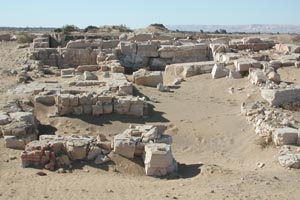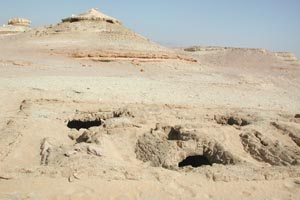|
In antiquity the temple at Ein Birbiyeh, in
Dakhleh Oasis, in the desert west of the Nile Valley, was filled to the
roof with wind-blown sand. Inscriptions indicate that this temple was dedicated
to the Egyptian god Amun-Nakht and the Roman emperors Augustus (30 BC-14
AD) and Hadrian (117-138 AD):
|
|
On the other side of the oasis, even further
to the west, is Bir Talaat el-Arab, an area with numberous ancient graves.
Most of these are comprised of rock-cut chambers, with a horizontal entrance,
few are shaft tombs, located around a vertical entrance. Others are vaults
built of mud-brick in a large pit:
|
|
|
|
|

|
|

|
|
|
|
|
|
|
|
|
Objective of visit:
|
|
To produce measured plans of
some of the many archaeological sites in Dakhleh Oasis, in particular of
the temple in Ein Birbiyeh and of some of the many graves in Bir Talaat el-Arab. |
|
Date of visit:
|
|
January 2005
|
|
Fellow visitors:
|
|
Dr.A.J. Mills, director of the
Dakhleh
Oasis Project, and some of the many other members of the Project. |
| Results: |
|
Accurate maps of the current
situation of the temple to Amun-Nakht and Augustus at Ein Birbiyeh and of
some of the many graves at Bir Talaat el-Arab. |
| Approximate
position and date of the site: |
|
Dakhleh Oasis is located deep
in the desert between the Nile Valley and Libya, southwest of Cairo and
Baharyah Oasis and northwest of Kharga Oasis and Luxor. The area appears
to have been inhabited, more or less continuously, for at least 400,000
years. The graves surveyed at Bir Talaat el-Arab probably date from the 6th-3rd
century BC whereas the temple to Amun-Naht dates from the first century AD. |
| Short
description of the site: |
|
More than 25 years ago Geoffrey Freeman
and Anthony Mills started a research project to study all human activities
in Dakhleh Oasis, in the desert west of the Nile Valley, which appear go
back at least 400,000 years. Inhabitants of the oasis burried their deceased
in the surrounding desert, just outside the oasis, according to the customs
of the period. During the Roman occupation of Egypt many areas were developed
for agriculture (cf. the
Fayum depression) much as this is happening today. To accomodate the
increased number of inhabitants several temples were built, including the
temple to Amun-Nakht and Augustus at Ein Birbiyeh. |
| Additional
remarks: |
|
This project would not have
been possible without the support of the Dakhleh Oasis Project and the
Supreme Council of Antiquities. |
| HOME |
|
|

|
|
|

